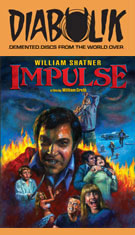
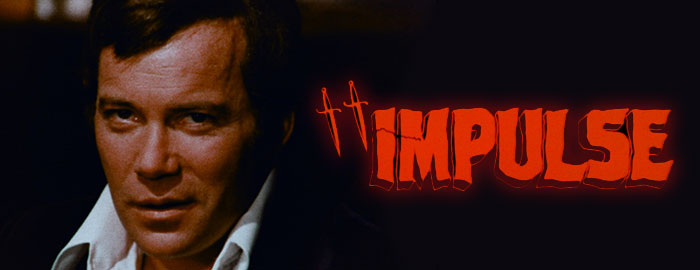
Color, 1974, 87 mins. 5 secs.
Directed by William Grefé
Starring William Shatner, Jennifer Bishop, Ruth Roman, Harold Sakata, Kim Nicholas, William Kerwin, James Dobson, Marcia Knight
Grindhouse Releasing (Blu-ray) (US R0 HD) / WS (1.85:1) (16:9)
In between his better known animal attack epics Stanley and Mako: The Jaws of Death, filmmaker William Grefé spent a little over two weeks in the 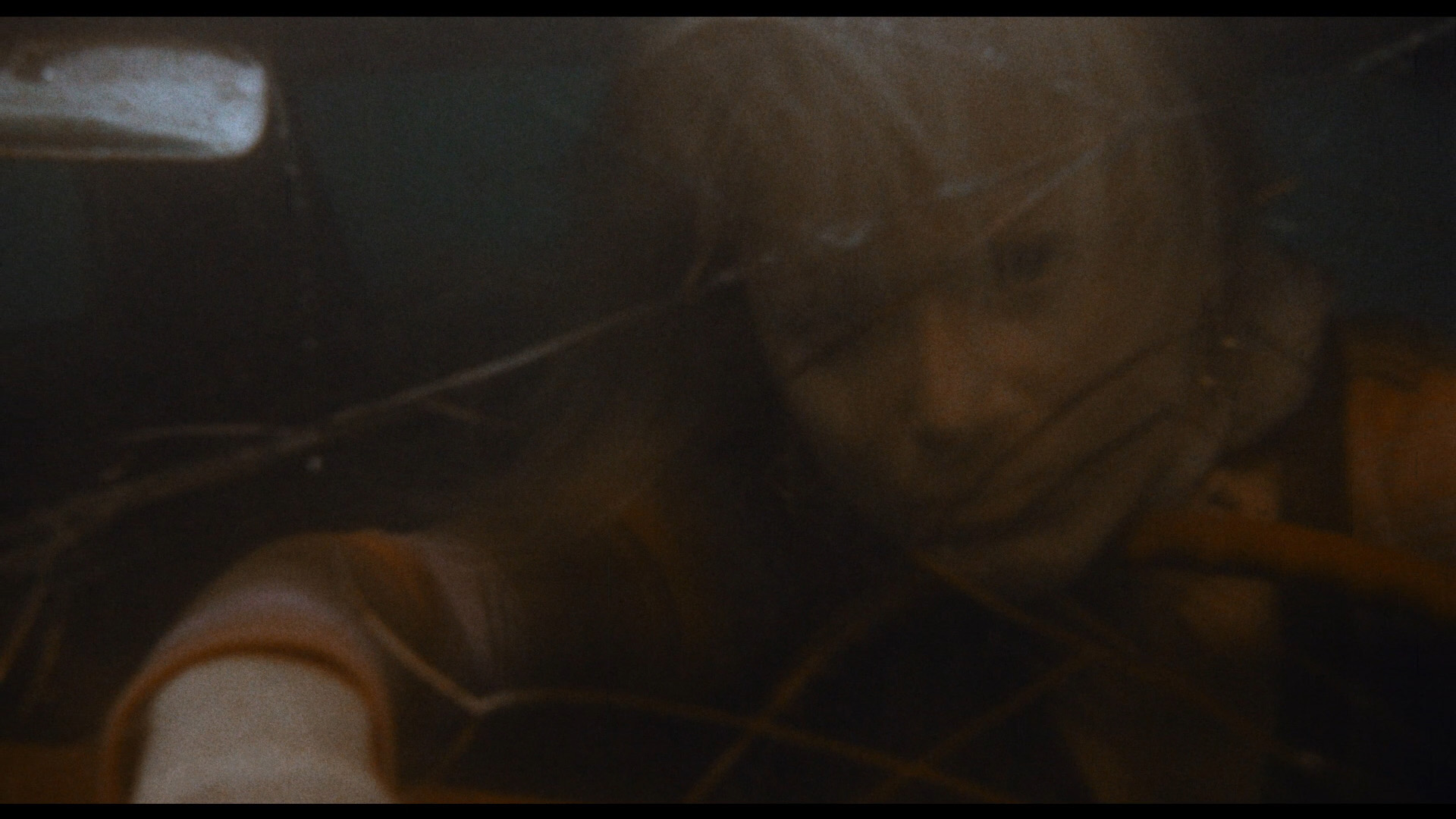 Miami area crafting Impulse, a wild and frequently indescribable horror vehicle for none other than
Miami area crafting Impulse, a wild and frequently indescribable horror vehicle for none other than 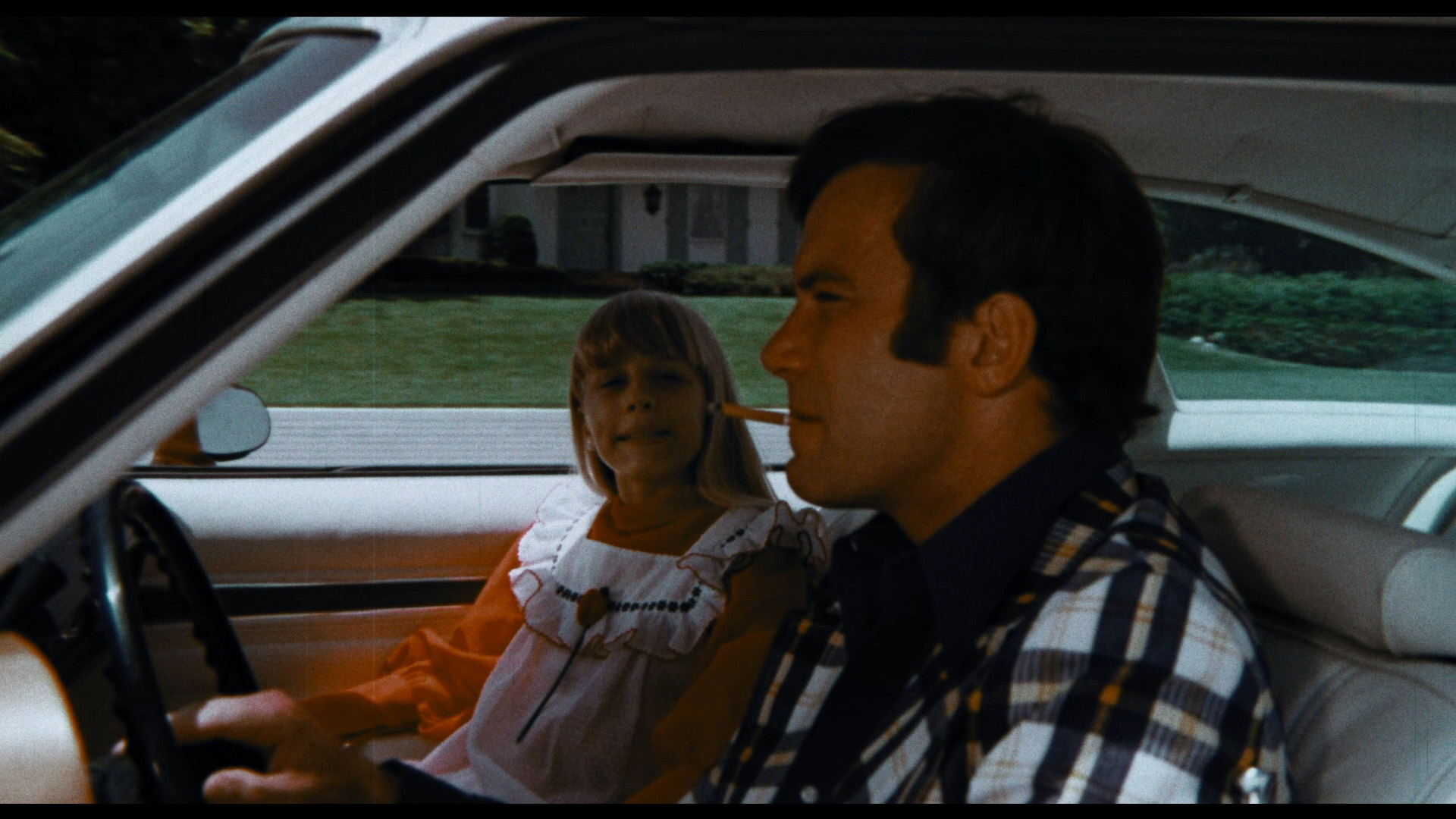 William Shatner at his most unhinged. With serial killers starting to seize the public consciousness thanks to widespread media coverage, this one slots in as a solid and very sweaty addition to other early efforts like the same year's Deranged. In this case the sex and violence was restrained enough to earn a PG rating at the time, but a mid-'70s PG is a long way from what would fly today; it's still plenty sleazy and intense with that bizarre Florida exploitation vibe seeping into every frame.
William Shatner at his most unhinged. With serial killers starting to seize the public consciousness thanks to widespread media coverage, this one slots in as a solid and very sweaty addition to other early efforts like the same year's Deranged. In this case the sex and violence was restrained enough to earn a PG rating at the time, but a mid-'70s PG is a long way from what would fly today; it's still plenty sleazy and intense with that bizarre Florida exploitation vibe seeping into every frame.
When Blood Feast's Bill Kerwin tries to rape his mom in the living room, little Matt Stone strikes back and ends up skewering the guy with a poker. Flash forward to the present day as a now adult Matt (Shatner) cruises nightclubs and picks up women thanks to his irresistible taste in leisure suits. However, after one show he gets into a fight with his current sugar mama Helen (Grefé regular Knight) over the attention he paid to a belly dancer, so he launches into a murderous strangling rage. A ruthless con artist, Matt sets his sights next on Ann Moy (The Female Bunch's Bishop), a solvent single mom whose daughter, Tina (Nicholas), catches on to Matt's dangerous true nature right away. Things escalate when Tina witnesses Matt's murderous handiwork firsthand, and only family friend Julia (The Baby's Roman) even tries to believe that something is terribly amiss with Ann's new boyfriend.
 In case it wasn't clear enough already, this is really the Shatner show with the actor kicking off a really bizarre phase in his career; he hadn't done a feature film since 1968 at this point, with this film opening just before Big Bad Mama and future favorites The Devil's Rain and Kingdom of the Spiders just around the corner. At the time he was busy working in TV, having come off of the live-action and animated Star Trek series and popping up in a wild assortment of made-for-TV features around
In case it wasn't clear enough already, this is really the Shatner show with the actor kicking off a really bizarre phase in his career; he hadn't done a feature film since 1968 at this point, with this film opening just before Big Bad Mama and future favorites The Devil's Rain and Kingdom of the Spiders just around the corner. At the time he was busy working in TV, having come off of the live-action and animated Star Trek series and popping up in a wild assortment of made-for-TV features around 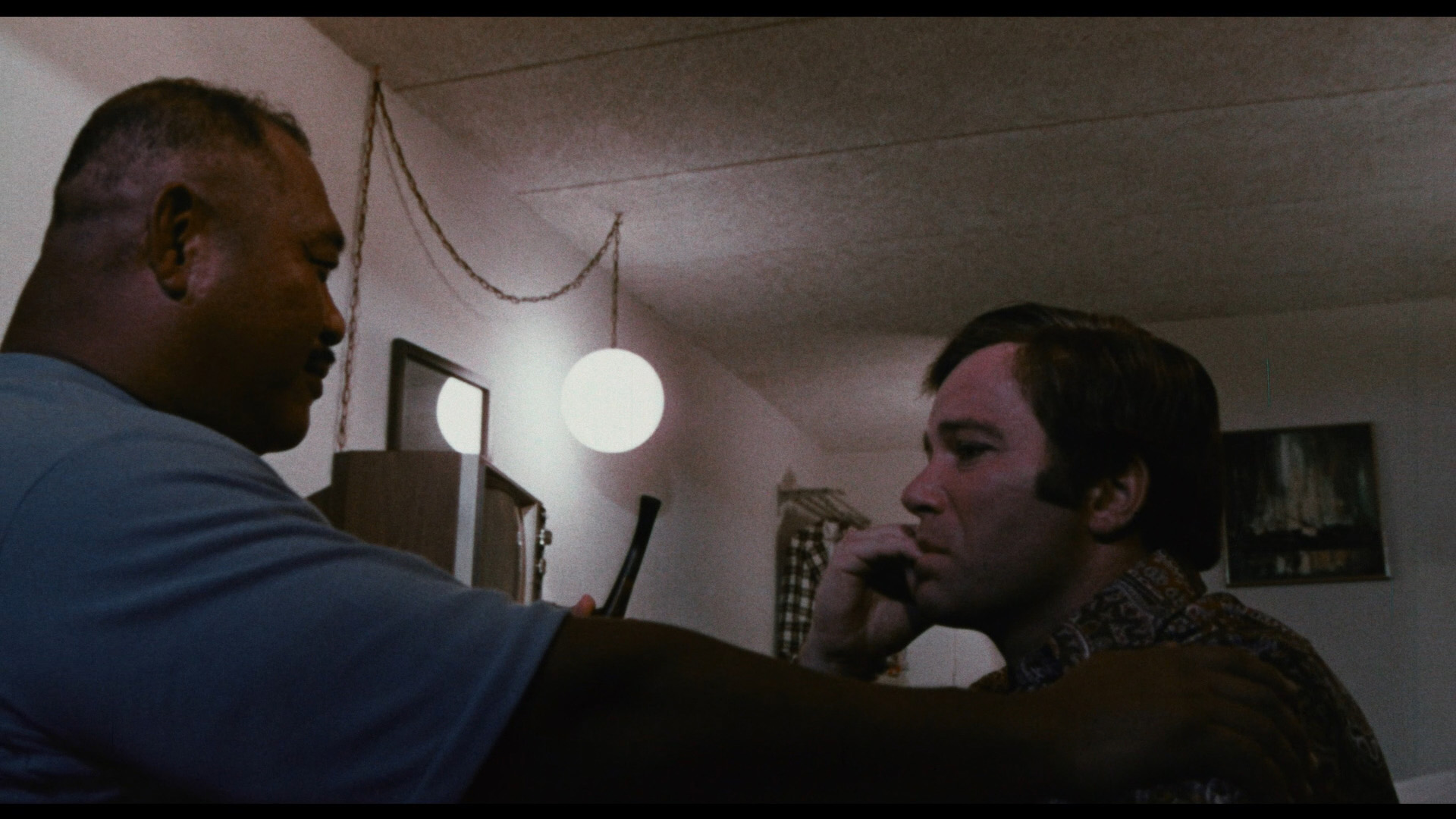 this time like Pray for the Wildcats, Go Ask Alice, and The Horror at 37,000 Feet. He's really something to behold here, especially in a protracted and apparently truly hazardous sequence involving what amounts to an extended cameo by Harold Sakata (Goldfinger).
this time like Pray for the Wildcats, Go Ask Alice, and The Horror at 37,000 Feet. He's really something to behold here, especially in a protracted and apparently truly hazardous sequence involving what amounts to an extended cameo by Harold Sakata (Goldfinger).
Given an independent theatrical release, Impulse popped up on VHS in the U.S. from IVE and then mostly sank into obscurity for decades apart from a handful of terrible, VHS-sourced gray market DVDs. Eventually it was resurrected by Grindhouse Releasing, who arranged limited theatrical screenings and issued a limited edition on Blu-ray in 2023. The retail version from 2024 has the same two discs (just minus some packaging bells and whistles), with the first Blu-ray devoted to the feature and a nice batch of extras. As an opening disclaimer notes, the negative for this film was destroyed a long time ago so the best option here was a rare archival 35mm print, with its fading and element damage mitigated here as much as possible. Nobody will ever say this is the greatest a/v showcase Grindhouse has ever released, but it's the best this has ever looked on home video and quite likely as pristine as it will ever be. The DTS-HD MA 2.0 English mono 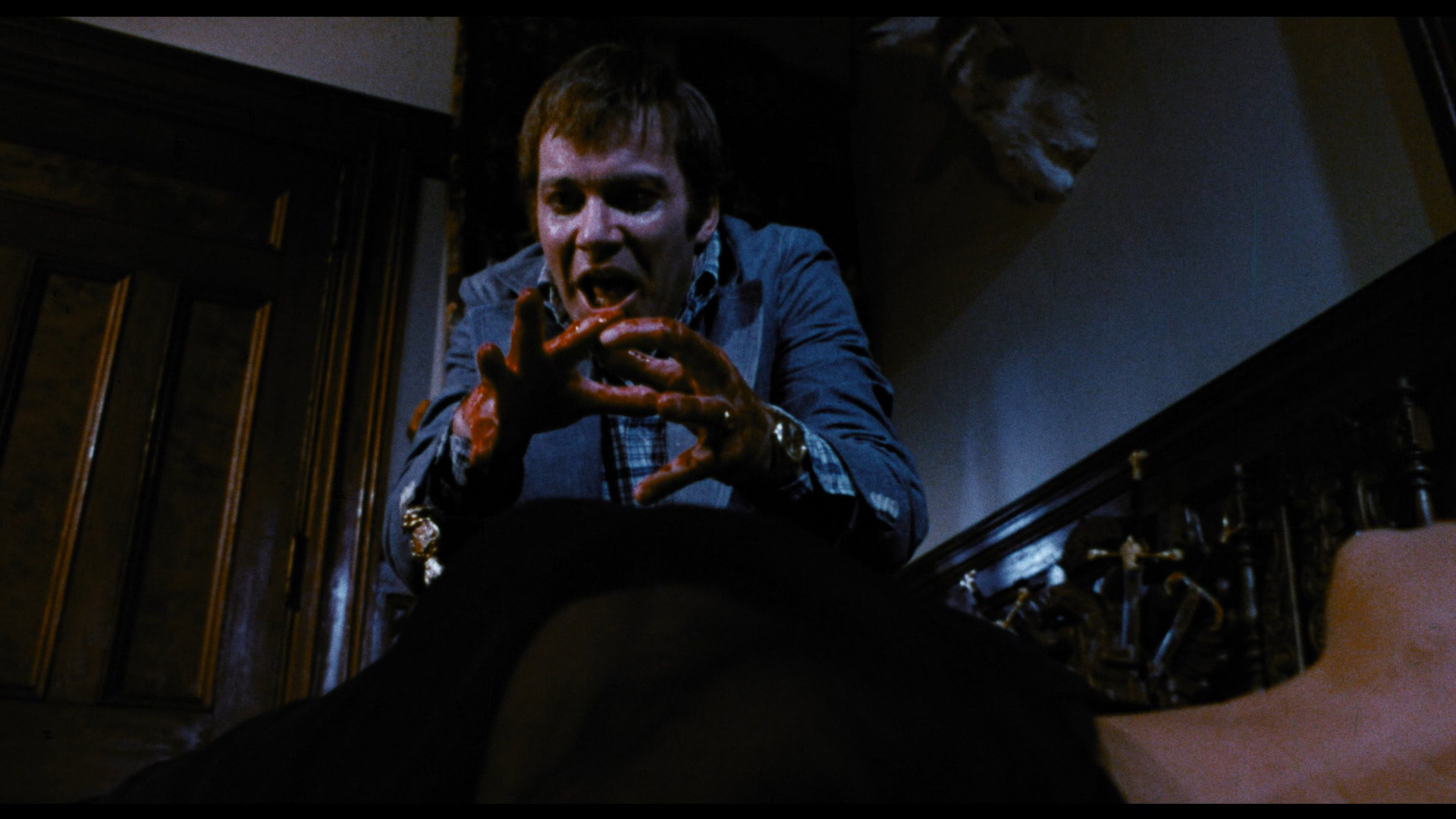 track is also fine given the limitations of the source; the "haunting alternate French track" and optional English SDH subtitles are also provided. Grefé delivers a new audio commentary that serves as a production diary more or less touching on the one scene he shows in film classes, the hotel swimming pool trickery used for one post-mortem sequence, the ins and outs of shooting around Miami, and lots more. He also appears in a new 14m27s making-of featurette (along with Frank Henenlotter, recorded separately) with more stories from the set and cast including "tough cookie" Roman. "Shatner Saves Sakata" (1m31s) is a wild bit of 16mm production footage of the two actors doing the film's most dangerous stunt, featuring commentary by the director or Shatner about the process of averting what could have been a horrible hanging accident on the set. Then you get a panel from the 10th anniversary screening in 2016 in Tampa (27m10s) with the director in conversation about the film; audio quality is pretty rough but it's nice to have some additional history of the film for posterity. Also included are two theatrical trailers, and
track is also fine given the limitations of the source; the "haunting alternate French track" and optional English SDH subtitles are also provided. Grefé delivers a new audio commentary that serves as a production diary more or less touching on the one scene he shows in film classes, the hotel swimming pool trickery used for one post-mortem sequence, the ins and outs of shooting around Miami, and lots more. He also appears in a new 14m27s making-of featurette (along with Frank Henenlotter, recorded separately) with more stories from the set and cast including "tough cookie" Roman. "Shatner Saves Sakata" (1m31s) is a wild bit of 16mm production footage of the two actors doing the film's most dangerous stunt, featuring commentary by the director or Shatner about the process of averting what could have been a horrible hanging accident on the set. Then you get a panel from the 10th anniversary screening in 2016 in Tampa (27m10s) with the director in conversation about the film; audio quality is pretty rough but it's nice to have some additional history of the film for posterity. Also included are two theatrical trailers, and 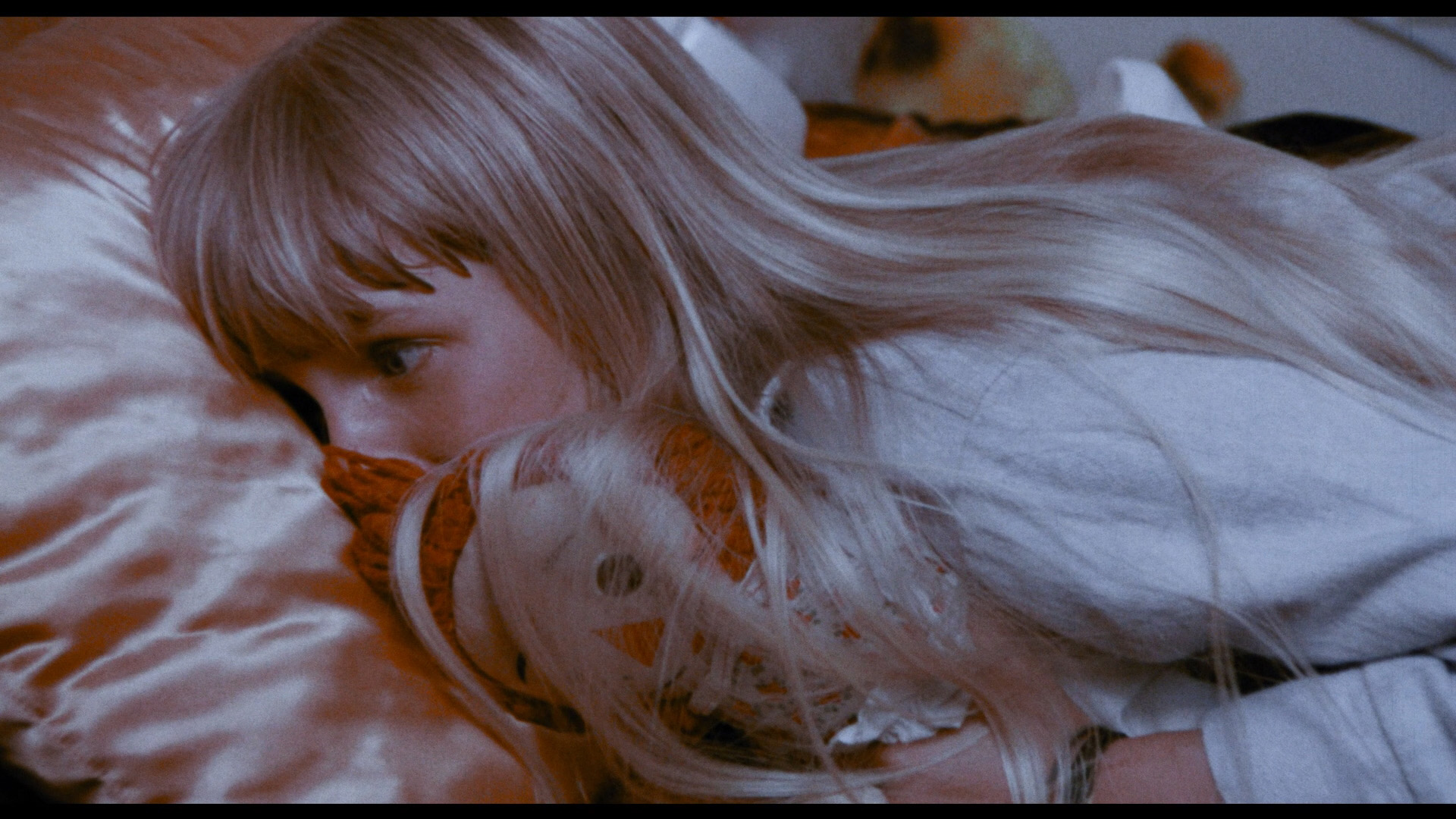 in typical Grindhouse fashion, two entire additional Grefé movies on the first disc: 1966's The Devil's Sisters, previously issued by Ballyhoo on DVD and presented here in the same SD scan with a reconstruction of the lost ending, and The Godmothers, a really strange G-rated mob comedy with Mickey Rooney (in drag). That one's pulled from a really rough SD source and comes with a 3m55s director intro, while Devil's Sisters ports over the DVD extras including a director commentary and 2m42s video intro, a 9m21s making-of featurette, a still gallery, and a radio spot, plus a new 1m20s addendum by Grefé.
in typical Grindhouse fashion, two entire additional Grefé movies on the first disc: 1966's The Devil's Sisters, previously issued by Ballyhoo on DVD and presented here in the same SD scan with a reconstruction of the lost ending, and The Godmothers, a really strange G-rated mob comedy with Mickey Rooney (in drag). That one's pulled from a really rough SD source and comes with a 3m55s director intro, while Devil's Sisters ports over the DVD extras including a director commentary and 2m42s video intro, a 9m21s making-of featurette, a still gallery, and a radio spot, plus a new 1m20s addendum by Grefé.
The impulsiveness continues on disc two, starting off with "Between the Treks: Shatner in the '70s" (26m26s) with C. Courtney Joyner studying the thespian's cult-friendly phase in the Ford and Carter eras (and also touching on his misguided '68 Euro western White Comanche), and "Kingdom of the Shatner" (64m37s) with the star giving very extensive chat about this film, his thoughts on indie moviemaking, and his mid-'70s career, at a screening at the Aero in Santa Monica in 2022. Then "The Corpse Speaks!" (33m58s) brings together Grefé with producer, makeup artist, and monster aficionado Doug Hobart, with loads of memories about their long history together well before this film (starting at a "cattle call" for Sting of Death in which he played the jellyfish monster) and including the production itself as well. "Bill Grefé Is Furious" (77m46s) is a more general, detailed overview of his "guerrilla" directorial career, beginning with his frustration at being called a swamp filmmaker and going through the many memories and lessons he racked up behind the camera. That's followed by "Bill's Miami Stories" (24m45s), covering his memories of his hometown including bits about Clark Gable and other colorful personalities, and "Bill's Sea Stories" (43m17s) about his sometimes very dramatic life experiences in other paths throughout his life. Then you get a 2011 Grefé interview (12m14s) adding more about meeting Orson Welles and the making of Stanley, a news report with Grefé about his work on Live and Let Die (2m39s), and Bruce Campbell introducing a Miami-based Legend Film profile with Grefé (9m25s). If that isn't enough for ya, how about three full indie filmmaking seminars (125m5s, 103m7s, 80m23s), William Shatner's insane Bacardi promotional short (19m32s) shot in Puerto Rico in '78, a "FAME" (First Artists in Media Entertainment) promo with Shatner (12m9s) directed by Grefé, "Investing in Movies with Lauren Bacall" (23m1s) featuring a lengthy interview with Grefé, and four recent-ish Grefé shot-on-digital short films: "Thumbs" (6m9s), "Iceman" (4m56s), "A Cask of Amontillado" (9m22s) starring the man himself in a film buff take on the Poe classic, and "Underwood" (21m9s). Finally you get galleries for production stills, press material, a Drive-In Delirium newspaper ad gallery, video releases, Grefé, the film's revival, and the new cover art by Dave Lebow. The set also comes with an insert booklet featuring an essay by underground filmmaker Jacques Boyreau, and as usual, Easter egg hunters with be rewarded with hidden goodies on both discs including The Dangerous Stranger (an educational short about the dangers of kids talking to random creeps), a performance by the band Polapse of a song directly inspired by the film, a brief Grefé anecdote tied to Deep Throat, a perplexing "Tina's Impulse" shot-on-video semi-sequel vignette in a graveyard, a Joyner recollection about writing "William Shatner's Full Moon Fright Night," and a hidden gallery for some of screenwriter Tony Trelos' lurid literary accomplishments.
Reviewed on April 15, 2024




 Miami area crafting Impulse, a wild and frequently indescribable horror vehicle for none other than
Miami area crafting Impulse, a wild and frequently indescribable horror vehicle for none other than  William Shatner at his most unhinged. With serial killers starting to seize the public consciousness thanks to widespread media coverage, this one slots in as a solid and very sweaty addition to other early efforts like the same year's Deranged. In this case the sex and violence was restrained enough to earn a PG rating at the time, but a mid-'70s PG is a long way from what would fly today; it's still plenty sleazy and intense with that bizarre Florida exploitation vibe seeping into every frame.
William Shatner at his most unhinged. With serial killers starting to seize the public consciousness thanks to widespread media coverage, this one slots in as a solid and very sweaty addition to other early efforts like the same year's Deranged. In this case the sex and violence was restrained enough to earn a PG rating at the time, but a mid-'70s PG is a long way from what would fly today; it's still plenty sleazy and intense with that bizarre Florida exploitation vibe seeping into every frame. In case it wasn't clear enough already, this is really the Shatner show with the actor kicking off a really bizarre phase in his career; he hadn't done a feature film since 1968 at this point, with this film opening just before Big Bad Mama and future favorites The Devil's Rain and Kingdom of the Spiders just around the corner. At the time he was busy working in TV, having come off of the live-action and animated Star Trek series and popping up in a wild assortment of made-for-TV features around
In case it wasn't clear enough already, this is really the Shatner show with the actor kicking off a really bizarre phase in his career; he hadn't done a feature film since 1968 at this point, with this film opening just before Big Bad Mama and future favorites The Devil's Rain and Kingdom of the Spiders just around the corner. At the time he was busy working in TV, having come off of the live-action and animated Star Trek series and popping up in a wild assortment of made-for-TV features around  this time like Pray for the Wildcats, Go Ask Alice, and The Horror at 37,000 Feet. He's really something to behold here, especially in a protracted and apparently truly hazardous sequence involving what amounts to an extended cameo by Harold Sakata (Goldfinger).
this time like Pray for the Wildcats, Go Ask Alice, and The Horror at 37,000 Feet. He's really something to behold here, especially in a protracted and apparently truly hazardous sequence involving what amounts to an extended cameo by Harold Sakata (Goldfinger).  track is also fine given the limitations of the source; the "haunting alternate French track" and optional English SDH subtitles are also provided. Grefé delivers a new audio commentary that serves as a production diary more or less touching on the one scene he shows in film classes, the hotel swimming pool trickery used for one post-mortem sequence, the ins and outs of shooting around Miami, and lots more. He also appears in a new 14m27s making-of featurette (along with Frank Henenlotter, recorded separately) with more stories from the set and cast including "tough cookie" Roman. "Shatner Saves Sakata" (1m31s) is a wild bit of 16mm production footage of the two actors doing the film's most dangerous stunt, featuring commentary by the director or Shatner about the process of averting what could have been a horrible hanging accident on the set. Then you get a panel from the 10th anniversary screening in 2016 in Tampa (27m10s) with the director in conversation about the film; audio quality is pretty rough but it's nice to have some additional history of the film for posterity. Also included are two theatrical trailers, and
track is also fine given the limitations of the source; the "haunting alternate French track" and optional English SDH subtitles are also provided. Grefé delivers a new audio commentary that serves as a production diary more or less touching on the one scene he shows in film classes, the hotel swimming pool trickery used for one post-mortem sequence, the ins and outs of shooting around Miami, and lots more. He also appears in a new 14m27s making-of featurette (along with Frank Henenlotter, recorded separately) with more stories from the set and cast including "tough cookie" Roman. "Shatner Saves Sakata" (1m31s) is a wild bit of 16mm production footage of the two actors doing the film's most dangerous stunt, featuring commentary by the director or Shatner about the process of averting what could have been a horrible hanging accident on the set. Then you get a panel from the 10th anniversary screening in 2016 in Tampa (27m10s) with the director in conversation about the film; audio quality is pretty rough but it's nice to have some additional history of the film for posterity. Also included are two theatrical trailers, and  in typical Grindhouse fashion, two entire additional Grefé movies on the first disc: 1966's The Devil's Sisters, previously issued by Ballyhoo on DVD and presented here in the same SD scan with a reconstruction of the lost ending, and The Godmothers, a really strange G-rated mob comedy with Mickey Rooney (in drag). That one's pulled from a really rough SD source and comes with a 3m55s director intro, while Devil's Sisters ports over the DVD extras including a director commentary and 2m42s video intro, a 9m21s making-of featurette, a still gallery, and a radio spot, plus a new 1m20s addendum by Grefé.
in typical Grindhouse fashion, two entire additional Grefé movies on the first disc: 1966's The Devil's Sisters, previously issued by Ballyhoo on DVD and presented here in the same SD scan with a reconstruction of the lost ending, and The Godmothers, a really strange G-rated mob comedy with Mickey Rooney (in drag). That one's pulled from a really rough SD source and comes with a 3m55s director intro, while Devil's Sisters ports over the DVD extras including a director commentary and 2m42s video intro, a 9m21s making-of featurette, a still gallery, and a radio spot, plus a new 1m20s addendum by Grefé. ![]()